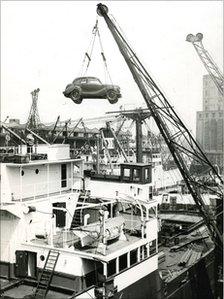Former workers recall working life of Salford Docks
- Published

The two remaining blue cranes were used on the old No.6 dock in Salford from 1966 to the early 1980s
"People should remember the history of the docks," says Salford mayor and former dock worker George Wilson.
Salford Docks, now renamed Salford Quays, was once one of Britain's busiest ports and an industrial powerhouse.
It employed up to 5,000 people moving goods in and out of Manchester until its eventual closure in 1982.
An exhibition currently at The Lowry, called Unlocking Salford Quays, recalls the industrial heritage of the area.
Fight to work
Built at the end of the 35-mile (56 km) Manchester Ship Canal, Salford Docks were opened in 1894 by Queen Victoria.
Ships weighing up to 12,500 tonnes (11,340,000 kg) delivered products from all over the world, especially America and Canada.
Although the main cargoes were cotton, grain and timber, commodities were brought from around the world, including tea, fruit, live and frozen cattle, lard, oil, petroleum and sulphur.
Exports included textiles, machinery, cars and locomotives, thanks to Manchester's huge industrial base.
The dock workers had to work 12-hour shifts and had to fight to get work if there were more men than jobs.
"There was good camaraderie, good friendship and a good community," recalled Mr Wilson.
'Hurdy Gurdys'
Raymond Probert, who maintained the docks, said: "The people were fantastic, they came from all walks of life."
"In the winter, it was very cold and you were working in the water all the time - it was hard.

Salford Docks declined in the 1970s
"In the summer, you could dive in the water, it was so hot."
In its heyday, more than 200 cranes used to be in operation at Salford Docks.
Today, just two remain.
In 1988 they were dismantled and re-erected on the present site as a landmark and a reminder of the working docks.
Mr Wilson used to drive the cranes, referring to them as the 'Hurdy Gurdys'.
"There were not many people who drove the cranes because they swayed so much.
"When they picked a load up, they swayed a foot forward, and when you released a load they swayed a foot back."
"It was a dangerous job," he added.
"There were ships in here queuing up like mad, and the idea was to unload and reload them as quickly as possible."
Docks' decline
Having grown to be the third busiest port in Britain, the docks began to decline in the 1970s due to the introduction of larger container ships which the docks could not accommodate.
This, together with Britain's increasingly dynamic aviation, motorway and railway systems, meant the docks were gradually becoming redundant.
The docks finally closed in 1982 with the loss of around 3,000 jobs.
The land was left derelict, and the surrounding waters polluted and useless.
In 1984, Salford Council purchased the docks and re-branded it Salford Quays, which has now been extensively redeveloped.
The site now includes The Lowry arts centre and outlet mall, MediaCityUK, Salford Watersports Centre and numerous apartment blocks.
What was once a thriving port in the heart of Manchester has been transformed into a modern hub for shopping, sports, entertainment and art.
Unlocking Salford Quays: The Inside Story is at The Lowry until 1 May.